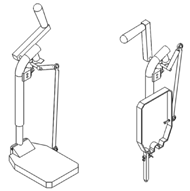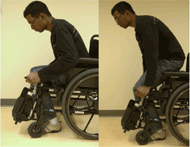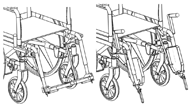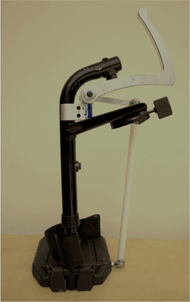Jeswin Jeyasurya1 and Jaimie F. Borisoff1,2
1 International Collaboration On Repair Discoveries, 2 British Columbia Institute of Technology
Introduction
North America and much of the world has a rapidly aging population. For instance, the proportion of seniors (over age 65) in Canada is expected to double to greater than 25% of the general population in less than 50 years; similarly, the proportion of those over the age 80 is expected to triple (Cranswick & Dosman, 2008). Aging is often accompanied by mobility impairments: approximately 81,000 Canadian seniors used a wheelchair in 2001 (Statistics Canada, 2006), and the manual wheelchair was third most important assistive device after eyeglasses and canes (Shields, 2004).
This aging population that uses wheelchairs often maintains the ability to stand and walk, and commonly requires the assistance of a caregiver. In Canada, 2.7 million senior caregivers were over the age of 45, with one quarter of that population themselves aged over 65 (Cranswick & Dosman, 2008). Any intervention or device that reduced the physical burden on aging wheelchair users and caregivers would be beneficial. Such improvements would also improve participation and contribute to better quality of life for these people.
Here, we focus on issue of sit-to-stand (STS) as it relates to manual wheelchair use. Prior to exiting or entering a manual wheelchair, a user typically has to lean down and either swing away the footrest hangers to the side, lift the footrests to the vertical retracted position, or often both.
Either motion can be difficult for some manual wheelchair users, particularly those with limited upper extremity mobility and/or limited forward leaning flexibility. Consequently, these users will constantly require help from caregivers to retract the footrest before they get in and out of wheelchairs. Retracting the footrests is also an awkward task for caregivers, who will have to bend over or crouch to raise the footrests. Additionally, physical contact with the footrests can be undesirable due to accumulation of dust and dirt onto the footrests over time.
After retracting the footrests the user must rise from a seated to a standing position to exit the wheelchair. STS is known to be a biomechanically challenging task in the older adult population, and over 6% of community dwelling older adults (Leon, J; Lair, 1990) and more than 60% of nursing home residents experience difficulty with rising from a chair (Mehr, Fries, & Williams, 1993). Research in STS among older adults reveals that knee extensor strength can be a limiting factor in successfully rising from a chair (Michael A. Hughes, Myers, & Schenkman, 1996). Research has also shown that functionally impaired seniors attempt to increase postural stability during STS by flexing the trunk forward prior to rising, thus decreasing the center of mass / base of support (COM/BOS) separation at the instant of liftoff (M A Hughes & Schenkman, 1996). Accordingly a method to guide an older user into a more functionally appropriate forward position before standing would be beneficial.
Previous designs have been developed to address footrest retraction, including devices described in several patents (Broyles & Boone, 2005; Fujihara & Fujihara, 2008; Szczepanski & Szczepanski, 2002). However, to the best of our knowledge, none of these have made an impact commercially, nor do these mechanisms additionally assist or support users with the STS motion after the footrests have been retracted.
The identified needs of a device to easily retract the footrests and facilitate STS from a wheelchair, and the lack of commercially available devices with this functionality provided the motivation to develop a stand-assist manual wheelchair footrest retraction device. This paper describes the design of this device and preliminary results based on therapist and user feedback.
Design Goals and Requirements
The primary design goal was to develop a lightweight, retrofittable device that enables wheelchair users or caregivers to easily retract the footrests without bending over and physically raising the wheelchair footrests.
Upon retraction of the footrests users with lower limb mobility will typically rise to a standing position. A secondary design goal was to use the device to facilitate the STS motion by providing a stabilizing support for users as they rise from their wheelchair.
These two design goals led to specific design requirements for the development of the footrest retraction device, as shown in Table 1.
Device should allow retraction of footrest without physical contact with the footrest |
Device should enable retraction of footrest by users without requiring forward lean more than what is typical when rising from a wheelchair. |
Device should enable retraction of footrests by caregivers without requiring the crouching or bending motion used to physically retract the footrests without the device |
Device should provide support for users to facilitate rising from the wheelchair without forward tipping of the wheelchair. |
Device should promote forward lean to guide users into a more biomechanically and functionally appropriate forward position before standing |
Design should be retrofittable to typical manual wheelchairs on the market in North America |
Weight of device should be less than 1kg |
DESIGN
 Figure 1: Wheelchair footrest with retraction device attached. Left image: footrest in horizontal (seated) use position; Right image: footrest in vertical retracted position.
Figure 1: Wheelchair footrest with retraction device attached. Left image: footrest in horizontal (seated) use position; Right image: footrest in vertical retracted position.The stand-assist footrest retraction device is designed to be used on wheelchairs with individual pivoting footrests that retract to a vertical position. Additionally, the device is designed such that the motion required to retract the footrests actually guides the user into a biomechanically functional position for standing and provides a handle to push on to support and assist STS from the wheelchair.
The retraction device is an accessory designed for simple attachment to existing wheelchairs with swing away, flip-up footrests. It is attached to the wheelchair via a bracket mounted to the hanger and a ball joint mounted to the footrest. A handled-lever pivoting about the bracket can be manipulated by the user such that motion of the handle retracts the footrest via two intermediate linkages that transmit force from the handle to the ball joint on the footrest (Figure 1).
 subject using handle to assist with STS. Left image: subject flexing trunk; Right image: subject pushing on handle during STS.
subject using handle to assist with STS. Left image: subject flexing trunk; Right image: subject pushing on handle during STS.Once the footrest is in the retracted position, the handle is well positioned for further use to support users with sit-to stand. The handle configuration encourages users to flex their trunks forward (increasing stability) and lean on the handle (reducing required knee strength) during the rise, thus promoting a safe and successful chair rise maneuver from the wheelchair (Figure 2).
 Figure 3: Wheelchair with retraction device mounted. Left image: footrests and anti-tipping posts in horizontal position; Right image: footrests and post in vertical position.
Figure 3: Wheelchair with retraction device mounted. Left image: footrests and anti-tipping posts in horizontal position; Right image: footrests and post in vertical position.When the user leans on the handles to assist with rising from the wheelchair, the vertical forces on the handles will be transmitted to the footrest hangers. Since the hangers are located substantially forward of the front wheels in these conventional wheelchairs, a large vertical force may cause the wheelchair to tip forward during the assisted STS motion. A forward anti-tipping mechanism has been incorporated into the device design to prevent this potentially dangerous forward tip of the wheelchair during the hand supported STS movement. It consists of a torsion spring-loaded post mounted to the bottom of the footrest hanger. When the footrest is in the horizontal position, the post also remains in a horizontal position directly underneath the footrest. When the footrest is raised to the retracted vertical position, the torsion spring causes the post to rotate in the opposition direction such that the post moves into a vertical position directly under the line of applied vertical force, and serves to stop forward tipping of the wheelchair (Figure 3). When the footrest is lowered back to the horizontal position it applies a force onto the post that causes the post to rotate back into the horizontal position.
Results
A fully functional prototype was fabricated (Figure 4). The prototype device easily attached to a wheelchair. Each retraction device was installed with a simple clamp at the top of the footrest hanger, a screw attachment to the footrest (necessitating a single hole drilled through each plastic footrest using a hand drill), and a screw attachment at the bottom of the footrest hanger using the existing screw that serves as the pivot for the footrest for its vertical movement. Installation is possible in approximately 15 minutes.
Occupational therapists and users with disabilities tried the functional prototype. Feedback was positive, noting that moving the footrests were straightforward and easy to do, and that their bodies were guided into a position that seemed advantageous to standing. It was also noted that using the device in the manner of a caregiver was also simple and reduced the amount of lean required to perform footrest retraction.
One therapist that provided feedback described a subset of clients in which their use of STS function from a wheelchair primarily served to facilitate transfers onto another seated surface. In this use, STS function is not a standard complete motion, but instead clients use their leg function to help slide from their wheelchair to another seated surface. Here, the footrests are retracted and hangers rotated laterally. In this case, clients may not require the STS functionality of the device, which would in turn negate the need for the forward anti-tipping mechanism.
The different use possibilities also point to commercialization opportunities in which at least two configurations are possible: one with the forward anti-tipping mechanism, and one without. Different uses also highlight the need to address the handle length in the upright position to ensure no interference when a user transfers, as well as needing to ensure no mechanical interference during retraction and the lateral swing away motion.
Conclusion
In summary, the stand-assist footrest retraction device provides the following: an easy to attach accessory to conventional wheelchairs; a levered device, simple to use, that requires little upper-extremity strength; a method for retracting wheelchair footrests using a motion that encourages proper biomechanics of STS; and a handle with built-in anti-tippers that can be used to assist with standing. A functional prototype of the device was shown to occupational therapists and users with physical disabilities and initial feedback has been positive. Results indicate that both wheelchair users and caregivers may derive benefits from using this design.
Future work will focus on obtaining further user and caregiver feedback regarding the design and usability of the device. This feedback will be used to drive further iterations of the design. Additionally, biomechanical analysis of users rising from the wheelchair with support from the device will have to be completed to determine if there are quantifiable benefits of using the device for support during rising.
References
Broyles, W., & Boone, D. (2005). Wheelchair footrest retractor. US Patent 6,880,845. Retrieved from http://www.google.com/patents?hl=en&lr=&vid=USPAT6880845&id=5AMUAAAAEBAJ&oi=fnd&dq=
Wheelchair+Footrest+Retractor&printsec=abstract
Cranswick, K., & Dosman, D. (2008). Eldercare: What we know today. Canadian Social Trends, 86(11), 48–56. Retrieved from http://www.statcan.ca/english/freepub/11-008-XIE/2008002/article/10689-en.pdf
Fujihara, K., & Fujihara, T. (2008). Manipulation device for wheelchair footrests. US Patent 7,347,497. Retrieved from http://www.google.com/patents?hl=en&lr=&vid=USPAT7347497&id=pG6pAAAAEBAJ&oi=fnd&dq=
Manipulation+Device+For+Wheelchair+Footrests&printsec=abstract
Hughes, M A, & Schenkman, M. L. (1996). Chair rise strategy in the functionally impaired elderly. Journal of Rehabilitation Research and Development, 33(4), 409–12. Retrieved from http://www.ncbi.nlm.nih.gov/pubmed/8895136
Hughes, Michael A., Myers, B. S., & Schenkman, M. L. (1996). The role of strength in rising from a chair in the functionally impaired elderly. Journal of Biomechanics, 29(12), 1509–1513. doi:10.1016/S0021-9290(96)80001-7
Leon, J; Lair, T. (1990). Functional Status of tbe Nomnstitutionalized Elderly Estimates of ADL and IADL Difficulties. DHHS Publication, 90(3462).
Mehr, D. R., Fries, B. E., & Williams, B. C. (1993). How different are VA nursing home residents? Journal of the American Geriatrics Society, 41(10), 1095–101. Retrieved from http://www.ncbi.nlm.nih.gov/pubmed/8409156
Shields, M. (2004). Use of wheelchairs and other mobility support devices. Health reports / Statistics Canada, Canadian Centre for Health Information = Rapports sur la santé / Statistique Canada, Centre canadien d’information sur la santé, 15(3), 37–41. Retrieved from http://www.ncbi.nlm.nih.gov/pubmed/15208888
Statistics Canada. (2006). Participation and Activity Limitation Survey 2006: Labour Force Experience of People with Disabilities in Canada. Statistics Canada, Catalogue(89).
Szczepanski, P., & Szczepanski, M. (2002). Foot rest lifting and lowering device for a wheelchair. US Patent 6,422,653. Retrieved from http://www.google.com/patents?hl=en&lr=&vid=USPAT6422653&id=koEKAAAAEBAJ&oi=fnd&dq=Foot+Rest+Lifting+and+Lowering+Device+for+a+Wheelchair&printsec=abstract
Acknowledgements
We thank Ernie Janzen for prototyping help during development and Ben Mortenson and Bonnie Sawatzky for feedback on the design and usage of the device.
